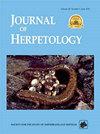北加利福尼亚州海拔梯度上海岸尾蛙(Ascaphus truei)的幼虫生活史:对气候变化的影响
IF 0.8
4区 生物学
Q3 ZOOLOGY
引用次数: 0
摘要
摘要沿海尾蛙(Ascaphus truei)分布范围横跨太平洋西北部,从美国加利福尼亚北部,进入加拿大不列颠哥伦比亚省,从海平面到bbbb2131米。以前的研究表明幼虫期是可变的,但没有明确区分海拔和纬度的影响。因此,我们在加利福尼亚北部的克拉马斯山脉(Klamath Mountains)的一个小纬度范围(29 km)内,沿着海拔152 - 2131 m的梯度,研究了真棘种群变态开始时的大小、幼虫期、个体生长速率和变态时间,以减少潜在的纬度影响。我们在15个研究地点采集了幼虫,其中6个地点作为捕获-标记-再捕获(CMR)的集中地点,另外9个地点用于补充幼虫期和变态期大小的数据。在CMR站点,我们单独标记蝌蚪以确定季节内的生长速率。我们发现,在这些种群中,低海拔和中海拔种群的幼虫期为2年,而高海拔种群的幼虫期为3年。我们还发现,随着海拔的升高,蝌蚪在变态开始时体型减小,生长速度加快。我们的高海拔种群在加利福尼亚有记录的幼虫期最长。不同海拔的真叶橐吾种群对气候变化的响应可能不同,其生长和变态时间与海拔的关系表明。本文章由计算机程序翻译,如有差异,请以英文原文为准。
Larval Life History of Coastal Tailed Frogs (Ascaphus truei) Across an Elevational Gradient in Northern California: Implications for a Changing Climate
Abstract. Coastal Tailed Frogs (Ascaphus truei) range across the Pacific Northwest from northern California, USA, into British Columbia, Canada, and from sea level to >2,131 m. Previous work has shown a variable larval period but has not clearly separated elevational from latitudinal effects. Therefore, we examined size at beginning of metamorphosis, larval period, individual growth rates, and timing of metamorphosis of A. truei populations along an elevational gradient from 152 to 2,131 m across a small latitudinal range (29 km) to reduce potential latitudinal effects, all within the Klamath Mountains of northern California. We sampled larvae at 15 study sites, of which we used 6 sites as intensive capture–mark–recapture (CMR) locations, and the other 9 for supplemental data on larval period and size at metamorphosis. In CMR sites, we individually marked tadpoles to determine within-season growth rates. We found that the A. truei larval period in these populations ranges from 2 yr in low and middle elevations to ‡3 yr in high-elevation populations. We also found decreased size at beginning of metamorphosis and increased growth rates of tadpoles with increasing elevation. Our high-elevation populations had the longest larval period documented in California. The associations of growth and timing of metamorphosis to elevation in A. truei populations suggest that responses to changing climate may differ across elevations.
求助全文
通过发布文献求助,成功后即可免费获取论文全文。
去求助
来源期刊

Journal of Herpetology
生物-动物学
CiteScore
1.60
自引率
0.00%
发文量
45
审稿时长
6 months
期刊介绍:
The Journal of Herpetology accepts manuscripts on all aspects on the biology of amphibians and reptiles including their behavior, conservation, ecology, morphology, physiology, and systematics, as well as herpetological education. We encourage authors to submit manuscripts that are data-driven and rigorous tests of hypotheses, or provide thorough descriptions of novel taxa (living or fossil). Topics may address theoretical issues in a thoughtful, quantitative way. Reviews and policy papers that provide new insight on the herpetological sciences are also welcome, but they must be more than simple literature reviews. These papers must have a central focus that propose a new argument for understanding a concept or a new approach for answering a question or solving a problem. Focus sections that combine papers on related topics are normally determined by the Editors. Publication in the Long-Term Perspectives section is by invitation only. Papers on captive breeding, new techniques or sampling methods, anecdotal or isolated natural history observations, geographic range extensions, and essays should be submitted to our sister journal, Herpetological Review.
 求助内容:
求助内容: 应助结果提醒方式:
应助结果提醒方式:


